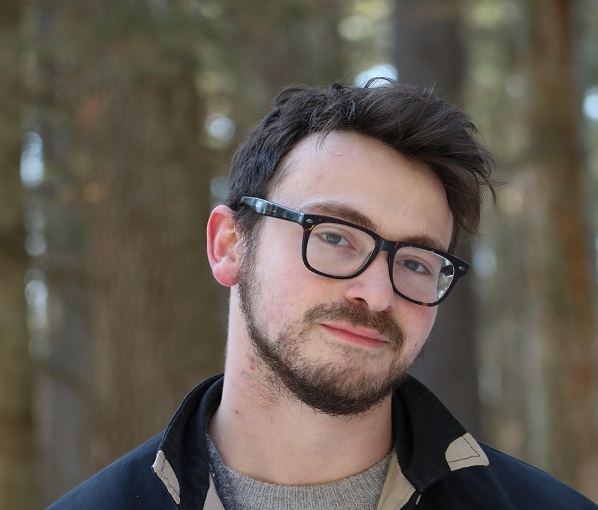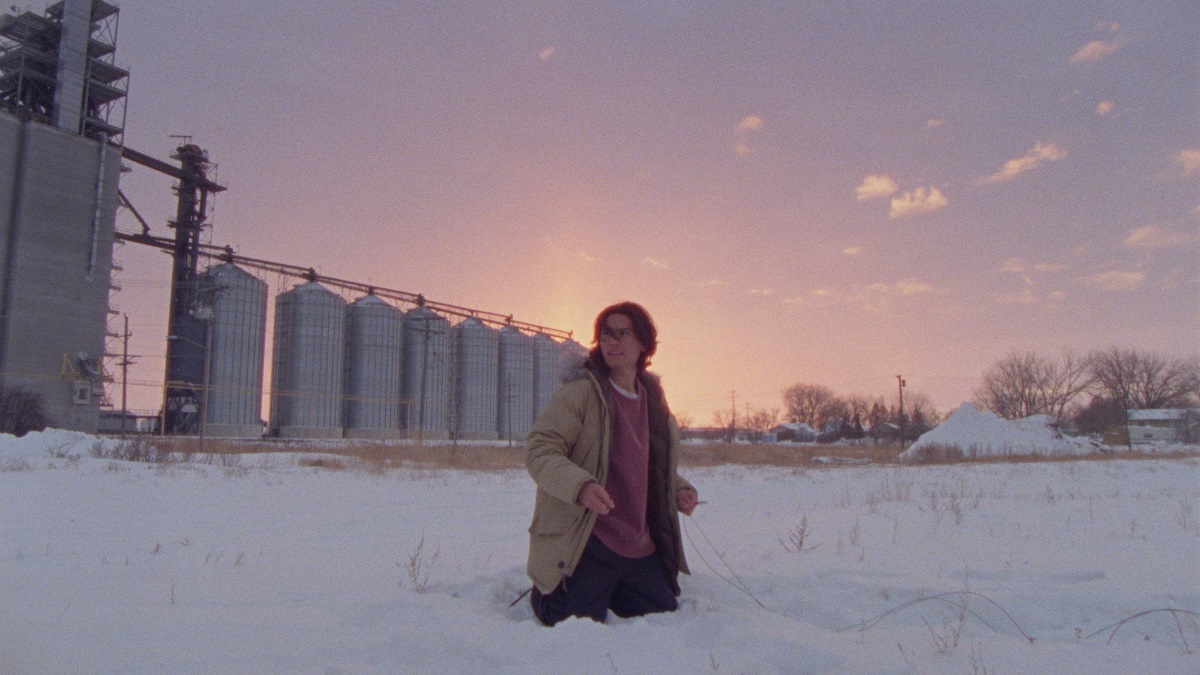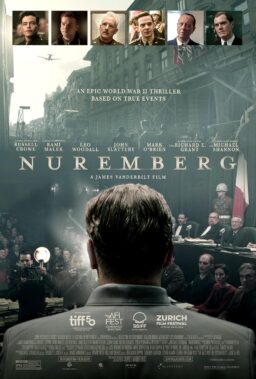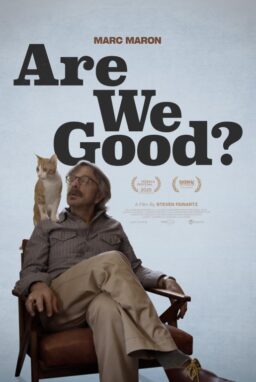“There can be no more excuses for passivity,” writes the Swedish environmentalist Andreas Malm in “How to Blow Up a Pipeline,” a call to action that New York filmmaker Daniel Goldhaber has heeded in adapting the author’s convincing defense of sabotage tactics in climate activism into a high-octane political thriller of the same name.
In theaters April 7, via Neon, “How to Blow Up a Pipeline” conveys with urgency, insight, and no shortage of adrenaline the story of climate activists who come together in western Texas to plot the destruction of a crude oil pipeline. Young people from all over the country, the eight protagonists—Xochitl (Ariela Barer), Theo (Sasha Lane), Alisha (Jayme Lawson), Shawn (Marcus Scribner), Logan (Lukas Gage), Rowan (Kristine Froseth), Dwayne (Jake Weary), and Michael (Forrest Goodluck)—are united by their belief that divestment, marches, and other peaceful forms of political protest are insufficient tactics for disrupting the fossil fuel industry. Instead resolving to attack its infrastructure, they assemble bombs and roll barrels with explosive charges to unguarded sections of a pipeline, seeking to dismantle the equipment that has poisoned their environments in the name of capitalism and propelled civilization toward ecological collapse.
Channeling and critiquing the tense, political provocations of movies like Bertrand Bonello’s “Nocturama,” William Friedkin’s “Sorcerer,” and Kelly Reichardt’s “Night Moves,” Goldhaber’s film—co-written by Barer and Jordan Sjol, shot on 16mm by Tehillah de Castro, and edited by Daniel Garber—is itself a collective action, employing the propulsive visual language of heist and Western films, along with a pulse-pounding electronic score by composer Gavin Brivik, to embed audiences with its characters and solicit sympathy for their risky, radical, emphatically justified actions.
Goldhaber’s last film, “Cam,” explored fractures of digital self, as a camgirl dueled a doppelgänger for control of her online identity, unfolding in a neon-lit virtual ether. “How to Blow Up a Pipeline,” in contrast, is viscerally present and grounded in reality, its characters pursuing collective action while struggling with raw materials in the dirt and dust of the sun-drenched Texas desert. Just ahead of its theatrical release, Goldhaber spoke with RogerEbert.com about his breakneck production period for “How to Blow Up a Pipeline,” its confrontational politics, and the surreal legacy of “Cam” online.
This interview has been edited and condensed.
We were interacting on Twitter minutes before this conversation, because of a post about “Cam,” and it’s true that film is one I think about whenever I think about crises of legitimacy online.
I’m perpetually online! And it’s funny to see the way “Cam” has changed in the culture, even from when we started making it. We started work on the movie before deepfakes were really even a thing. We saw it as this more surreal, psychological thriller. Then, all of a sudden, it wasn’t even sci-fi. It was almost feasible. And the movie has changed and developed even since then, in terms of the ways online identity has become that much more corrupted over time.
I was thinking about this earlier today, seeing AI-generated images of Trump in handcuffs that some had believed to be real, considering how our sense of reality is disrupted by how we interact online.
Absolutely. It’s something I think about a lot, the level to which we have traded our sense of reality over to the digital realm. Even the fact that, if you want to look at a restaurant menu, you need a smartphone. That’s crazy! That doesn’t make any sense. It leaves us so exploitable. Our identities are so exploitable. There was an emotional reality to it in “Cam,” but I don’t think that we understood just how serious the practical reality was when we were making the movie.
In discussing “How to Blow Up a Pipeline,” I first want to just state that it’s been wildly impressive to see how far it’s come so fast.
For me, it seemed like there were two and a half years of nothing. Then, all of a sudden, there was just this burst of energy and inspiration, and a breakthrough, with this movie for us.

You made this film in just over 18 months. That unusually rapid pace is reflected in your filmmaking, which pulsates with this exhilarating, impulsive energy. Tell me about that timeline and leaning into a certain forward propulsion in how you directed the film and edited it with Daniel Garber.
The style was a product of the production but, also, we knew that that was going to be the case. There were a lot of reasons that we needed to make this movie as quickly as we did, not least of which is that this is a political conversation that needs to happen immediately. We are on a timeline, in terms of serious action on climate change, that can be measured in months — not years, definitely not decades. For us, this film is something that we feel like we can do to change the cultural conversation, to shift the way we talk and think about climate and the tactics that the climate movement is using — but we have to do it now.
There were also industry timing [considerations.] I had a sense the movie would do very well at TIFF and, if we were going to get the movie done by TIFF 2022, we needed to start production in November. But even while we were doing it, moving as quickly as we were, most people on the movie, myself included, were like, “This is crazy. Should we be doing this?” We kept returning to the idea that this is an impulsive, youthful movie about an impulsive, youthful, necessary act, and that we should have that same energy ourselves. I’m perpetually a believer in the idea that every movie is a documentary of its own making, to some extent. The process of making the film becomes inseparable from the film itself by the end of it. Knowing there was a fusion between the idea of what the movie would be and the way that we were making it, there was a sense of faith, even in the darkest moments, that it was all going to work out.
You don’t only see that in the style of the film but also and especially in the performance. It’s relevant to say that it was an energy everybody had to take up. We were like, “We’re going out there. We’re doing this for real. It’s going to be intense. We’re going to get dirty. But it’s going to be worth it in the end.” Every single person who worked on this movie had to believe in that idea and had belief in the idea that this was an important conversation to start. That’s something you can’t totally fake. It was a leap of faith on everybody’s part, but one I do think worked out.
One way you feel that energy is in how these characters talk to each other. They debate pros and cons of this collective action they’re working toward, clearing a high bar in terms of both the substance and nuance of their discussions about climate activism, but this never feels inorganic to their politics and backstories. Co-writing with executive producer Jordan Sjol and producer and actor Ariela Barer, how did you find that union between theory and character in the dialogue?
It’s interesting, because we’re obviously adapting a manifesto, a nonfiction work, and an academic text. And so we didn’t just feel a responsibility to the underlying source material. Andreas’ argumentation is compelling. It’s one of these [challenges] I also faced with “Cam,” where—when people read a script about a subculture like this, that’s outside of the norm—they want it explained to them, and they need to understand all of the reasons why somebody would do something like this. But then you end up just having an empathetic lens trained on a great actor; all of a sudden, those reservations evaporate. But we had a similar writing process on this film to the one we had on “Cam,” where there was a lot more material in the script that ultimately we didn’t need, because the actors and the performances lent so much empathy and reality.
It was mostly a process in the editing room. We had all of the theory written, and we had it shot, but when we got into the edit, we realized just a little bit goes such a long way. You don’t need a lot of the rhetoric or the argumentation to buy into what the characters are doing. It was this delicate process of carving it away, asking how little of the theory we could have without shortchanging any of the underlying ideas. That was a place where it was also great to have collaboration and dialogue with Andreas, because he was reading drafts of the script and looking at cuts. He was always somebody we could turn to, and so he served as a creative backstop in that way.

The characters all represent the human toll of climate change: oil refinery-related cancer, death from heatwave, destruction of indigenous lands and cultures. This legitimizes their individual justifications of disruptive action as an act of self-defense, though they call for a larger movement to embrace their strategies. I found this fascinating both as a way of strengthening audience sympathies for these characters and as a narrative repudiation of the corporate argument that the responsibility for solving ecological disasters lies with individuals rather than corporations that poison those individuals.
It started from a standpoint of research. We read the book, we knew what we wanted to do, and we knew this was going to be a heist film. One of the great things that a heist film suggests is an ensemble and collective action. That’s inherent to the heist genre. As part of that collective action, we knew we would have an opportunity for this to be a cross-section of all of the different kinds of people involved in the American climate movement. Once we had that thesis together, we had to figure out who those people were and where they would come from. That was just a research process of meeting with activists that Andreas connected us to, connecting with bomb experts, connecting with pipeline experts. It was a similar research process with “Cam.” You start from a standpoint of saying, “We’re thinking of doing this movie. What do you think it should be? How do you feel like you would need to be represented by a film about this subject matter?” You don’t start from a standpoint of asking somebody to rubber-stamp your project.
There’s a number of people that we ended up more seriously collaborating with, who are credited as script consultants on the project. It was ultimately a combination of their insights and us starting from a place of saying, “Look, this is a work of fiction. We don’t really know who in the world would actually do this. We have to write from the place that we know. We have to be writing, ‘What if us and our friends went and did this?’” We have to be writing from a place of what’s immediately tangible to us, that feels like it could be something that believably results in this kind of action.” We all were writing ourselves into the film in different capacities and talking about very personal relationships that we have with this subject. It was a combination of all those elements.
You graduated from Harvard University in 2013. I graduated from Northeastern, a few miles away, a few years later. The reason I mention this is that, while “How to Blow Up a Pipeline” was published in 2021, I first saw property damage and sabotage as legitimate activist tactics during Black Lives Matter protests in Boston, during which time BPD had its tires slashed, and a cruiser torched. When were you first introduced to these concepts, and was it reading the book that radicalized you to them?
It’s something that’s been around and that I’ve interfaced with similarly. Even going back to Occupy Wall Street, which is what was going on when I was in college, this is something that’s been in the air. But the thing about the book that’s novel, fresh, and so effectively argued and codified by Andreas is the idea that the infrastructure is the enemy. You can come up with all these justifications for attacking BPD cruisers, for destroying and sabotaging all sorts of industrial property. But when it comes to the question of climate change, what is the target? And Andreas takes all of that historical legacy, and he says, “It’s the machines that are killing us. If you have a refinery in your backyard, if you have an oil pipeline that’s leaking into your water supply, why is that not seen as violence? Why is the destruction of that thing that is causing death seen as violence? And is it violence? Or is it self-defense?” It’s that specific moral argument he creates around climate that’s so compelling. And so even though these were ideas that I had been familiar with, this way they come together and intersect with both climate and also an action that suggests an inherently cinematic story, was the reason this book touched off the film.
It’s also worth saying that my parents have worked in climate science my whole life. This has always been near and dear to me. Some of the expression of rage and passion that’s part of the project also just comes from my own personal experiences, sitting on the sidelines of the climate debate for 30 years and not knowing what to say or do. That’s what was so inspiring about Andreas’ book and also so inspiring about—being a filmmaker and trying to feel like there’s any sort of relevance in filmmaking—being able to provoke this question of, “Is there a justification of self-defense for the destruction of fossil fuel infrastructure?” It’s a productive, useful question to ask loudly, excessively, and provocatively.
As Xochitl says, “Structural damage is the point.” We’re always seeing the infrastructure rather than the individuals, such as oil executives shaking their fists or being blown up along with the property.
And that was something that we hit on early on. It’s part and parcel with something that’s very foundational to Andreas’ book, which is that there is no one person, no one company or government, that is responsible for climate change. We all have participated in climate disruption, for some people to a far greater degree and for other people to a far lesser degree. But, if you consume, if you travel, if you exist in almost any capacity in our modern world, you’re participating. And I think that a failure of narrative has been trying to pin that on the individual, even symbolically in narrative. That’s one of the things that leaves people feeling some degree of hope, or excitement, or thrill after the film. This notion of seeing an enemy that’s just a hunk of metal is actually very empowering, because [attacking] that doesn’t feel like such a morally complicated act all of a sudden. In all the ways that you think about these movies that engage with a human simile of the fossil fuel industry, I think one understands the fraudulence of that, when it comes to the actual nature of the systems that run our world. To see something that actually speaks truth to that, and then to understand how that can be something that can be directly confronted, is empowering and interesting. It’s at the heart of a question of justifiable tactics in a way that’s very productive.

It’s also tactile and grounded. To depict the rolling of a barrel or the use of straps to coordinate lifting one, that material quality makes the characters’ aspirations feel so achievable and practical rather than theoretical.
That was the stylistic goal of the project. That’s why we show the bomb building, right? It’s not because we’re actually showing people how to build bombs. It’s for people to understand how easy it is to build bombs. You’re just watching it, and you know these materials. It’s familiar. You can imagine yourself doing it. That’s the provocation, is its possibility, not the fact that there’s actually an instruction manual. Writ large, that was our stylistic goal across the board: wanting the audience to feel like this was actually happening, that they were almost participants in it. That in itself is also provocative, because it’s not othering. You’re inviting the audience in, almost in a very warm capacity, and asking them to identify with these characters, to empathize with these characters. To do that is to fly in the face of the common narratives around contemporary revolutionaries, where they’re branded as simply destructive, violent, terrorist criminals. Instead, you see these eight kids that you relate to, and you can even feel their labor in a way that you’re rooting for. You’re rooting for them to get the barrel up the hill. That’s complicated and exciting.
That participatory nature of the film was inherent to literally every stylistic decision we made, from the 16-millimeter film that we shot on to these Steadicam moves where you feel like you’re literally walking around with them to the lack of what we would call editorializing shots that felt like the hand of the filmmaker saying, “Look how badass and cool this is.” We’re asking the audience to be cinematically present.
As someone whose previous film mediated the distance between online and real-life identities, I’m curious about the scene of doom-scrolling you include and the degree to which the importance of physical presence rather than online connection determines the success of this collective action.
It’s not just that Twitter contributes to noise. Instead, it actively creates anxiety, and it creates a sense of powerlessness. And that’s what you see in Shawn in that scene you mention, where he’s holed up in his dorm room, feeling totally powerless and isolated. Then, he makes this call, he gets out of bed, and he starts planning something. He engages with the real world.
That’s the problem with trying to organize on social media, is that social media is not some unbiased or objective communication platform. It’s a video game that is structured to keep you playing it as much as humanly possible. I think that we have this problem where we believe that we’re living when we’re on social media, that we’re living when we’re posting, that we’re still engaging with the real world. But we’re not. We’re fundamentally not.
At its core, this is a movie that was born out of a year of COVID lockdown, of being online, of trying to participate at least a little bit in the Black Lives Matter protests of 2020 but also feeling hamstrung in that because of COVID isolation and the fundamentally online nature that those protests had, even when they were engaged in the real world. For us, it was about, “We got vaccinated. Let’s get out of the house, and let’s go do something.” On some level, that’s also what the movie is about and what the movie is capturing: a bunch of people who’ve reached the end of their rope and need to go do something.
I’m about to make another online movie called “Faces of Death,” but it’s the most maddening thing in the world to do. I had sworn after “Cam” that I would never do it again, and now I definitely will never do it again because the problem when you’re making a movie that’s very online is that you’re not just making one movie. You’re making the movie, but then you make the online movie that’s inside the movie. That’s a whole process, especially when you’re making a film, because the nature of being online is that there’s no IP law online, not really. You have this thing that’s crowd-sourced from a couple billion people, all of the content on it, and you’re trying to represent that diversity through images that you know your studio’s legal department has cleared. That’s a nightmare. And it’s not a particularly creative process. It’s very hard to replicate the reality of the digital experience, especially because there’s not a formal department that ever exists to handle that. I love the way that I’ve been able to do online movies, but at the end of the day I prefer existing in the real world.
Setting the film in West Texas—outside of the logic of it being an open, unguarded, and thus vulnerable position at which to hit the pipeline— places the movie in dialogue with Westerns, with their wide-open swaths of Americana, and I’m curious about the symbolic power of assembling your characters there.
I appreciate you calling it out as a Western. Jordan had come to visit me for December 2020, because we were working on another project, and I was trying to find something to write with Ariela. The three of us ended up podding up over the holidays, hanging out a bunch and watching a bunch of movies together. I was researching this one project with Jordan. Ariela was researching this other project that she was writing, which was a Western, so we were watching a lot of Westerns together. I was stuck on what I was doing with Jordan. Ariela was stuck on her Western project. Then, this book came around, and we were like, “This is everything!” We were so excited about finding an actually novel way into a Western for 2023.
And it’s also worth noting that the heist film comes out of the Western. What’s the first heist movie of all time? What’s the first action crime movie ever made? It’s “The Great Train Robbery,” a Western. The entire idea of a posse getting together to rob a bank is a Western notion. It’s an American notion. It’s so firmly baked into our culture, a gang of outsiders taking back agency and control from the man. And the nature of inequality, trying to conceptualize that revolution, when the thing that you’re taking on is the destruction of our world, is a very challenging problem. But we wanted to tackle that in a way that felt familiar. Using those Western tropes, and using some of that steel-guitar twang that pops up in the movie every once in a while, is a way of reminding the audience this narrative isn’t new. We’ve been dealing with this as Americans, as subjugated people, since time immemorial. This is just what it looks like today.
“How to Blow Up a Pipeline” opens in theaters on April 7, via Neon, before expanding nationwide.












